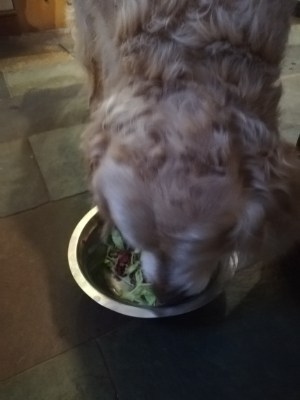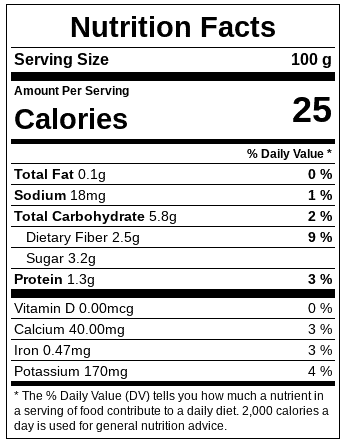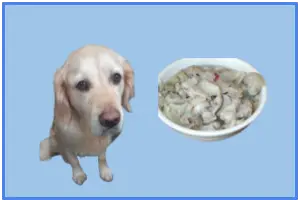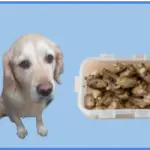
It is only really quite recently that I have realised how much I like the taste of cabbage.
I mean not raw cabbage but lightly steamed green cabbage.
And red cabbage is a real treat.
Like most vegetables, cabbages need to be peeled.
And I’m not talking about using a physical peeler, I’m talking about the way that we tend to shed the outermost leaves before we start preparing it for our dinner.
I feel uncomfortable with this and I tend to put these leaves to one side ready to give to my dogs with their next meal.
But is giving my dogs raw cabbage ideal?
Or is steaming it the way to go?
Can dogs eat raw cabbage?
Raw cabbage is perfectly safe for your dog to eat.
There is a minimal risk to your dog from a toxin called thiocyanate- which is only a danger if your dog eats bucket loads of the stuff over a period of weeks.
And if that frightens you a little, then just gently steam the cabbage to destroy the toxin.
Otherwise, raw cabbage is great because it comes in a variety of textures and it contains lots of vitamins and minerals (mainly vitamins) which can boost your dog’s health.
Cabbage is easy to get hold of all year round, it is cheap to buy and many of us have one sitting in the vegetable drawer in our fridge.
And so the question is, what’s stopping you?!
What are the main types of cabbage?
Whether we prefer Green cabbage, Red cabbage, Napa cabbage or even a Savoy cabbage we are spoiled for choice when it comes to the range of different cabbages that we can buy at our local grocery store.
I don’t know about you most of the cabbages that I consume tend to be green cabbages or savoy cabbages.
In the next section, I look at all of the different nutrients that can be found in a cabbage and by and large, no matter what type of cabbage you buy, the nutrients that they provide are very similar.
How nutritious is a raw cabbage?

On your right is a box showing some of the most important nutrients in a 100 g portion of raw cabbage.
And I don’t think that there are many surprises here.
It has very few calories, it is low in fat, salt and protein but it is high in the amount of fiber that it has.
The main vitamins that are contained in a raw cabbage are Thiamin (B1) (.061 mg) , vitamin B6 (.124 mg), vitamin C (36.6 mg) and Vitamin K (76 mcg.
The main minerals that are contained within raw cabbage are calcium (40 mg), phosphorus (26 mg) and potassium (170 mg.)
But how do these relate to the nutritional needs of a dog?
Well, scientists know exactly what the vitamins and minerals that your dog needs are.
And they know this down to the smallest detail.
And each nutrient is expressed as either a percentage or as an amount per kg- or in our case per 100 g.
| Vitamin | Raw Cabbage (100 g) | Dog amount |
| Riboflavin (B2) | .04 mg | .52 mg |
| Thiamin | .61 mg | .225 mg |
| Vitamin B6 (pyridoxine) | .124 mg | .15 mg |
| Vitamin C | 36.6 mg | – |
| Vitamin K | 76 mcg | – |
I have created a quick chart for you to look.
The first column contains a list of the most common vitamins found in raw cabbage.
Column 2 contains a list of the exact amounts of these vitamins found in a 100 g serving of cabbage.
And the third column displays what a dog requires. How much of each vitamin do they need per 100 g of food that they eat.
The first thing to note is that vitamin C and vitamin K have “blank” values in the third column because dogs do not need vitamin C and vitamin K in their diets.
Who knew?!
Next we can see that a dog needs more riboflavin than raw cabbage can provide but that cabbage provides more thiamin than a dog needs.
Vitamin B6 is provided in the right quantity for a dog.
Now, don’t worry about these differences.
It doesn’t mean that you shouldn’t feed raw cabbage to your dog, I’m just trying to show how raw cabbage fits in.
Hopefully your dog will be on a complete diet which meets all of their nutrition needs without a bit of raw cabbage.
A bit of cabbage now and again will just act as a booster, if you will.
Now it is time to look at the minerals.
| Minerals | Raw Cabbage (100 g) | Dog amount |
| Calcium | 40 mg | .04% |
| Potassium | 170 mg | .17% |
| Phosphorus | 26 mg | .026% |
| Iron | .47 mg | 11.7% |
Column one shows the four of the main minerals found in cabbage .
Column two shows the exact amount of each mineral in a 100 g serving of raw cabbage.
Column three shows how much the percentage amount that a dog needs.
So, 40 mg of calcium is .4% of what a dog needs in their diet.
And so, raw cabbage doesn’t pack a punch when it comes to a dog’s mineral needs!
But as I said, don’t worry about that because they should be getting these minerals from their main meal.
Raw vs cooked cabbage: nutrition
In this next section, I want to look at whether cooking cabbage changes its nutrition.
And it does, cooking a cabbage reduces the levels of vitamins.
The amount of riboflavin, thiamin and vitamin B6 were all reduced by between 10- 20%.
It is the same with minerals, cooking a cabbage also destroys some of the mineral content.
The levels of calcium, potassium, phosphorus and iron are all reduced by about 10% by cooking them.
Raw vs cooked cabbages- pros and cons
Odour
I have read on a few dog blogs that because raw cabbage is harder to digest than cooked cabbage, you can expect your dog to produce more unpleasant smells if they eat raw cabbage.
Apparently, part of the cause of the smell is the fibre content in the cabbage.
You see, raw cabbages have a higher fibre content than cooked cabbages.
Or green and savoy cabbages do.
Red cabbages don’t have a higher fibre content when they are raw.
Cooking a red cabbage increases it’s fibre content.
Here’s another chart.
| Type of cabbage | Raw fibre content | Cooked fibre content |
| Savoy | 3.1 g | 2.8 g |
| Green | 2.5 g | 1.9 g |
| Red | 2.1 g | 2.6 g |
So if you have your heart set on feeding your dog raw cabbage and you are concerned about dog farts, try feeding them some red cabbage…
- Thiocyanate
Thiocyanate is a toxin which is found in raw cabbages which if ingested in big enough quantities over long periods of time can damage how the thyroid gland works and lead to hyperthyroidism.
The only workaround is to cook the cabbage.
I can’t find any details of how much thiocyanate a raw cabbage contains, how much a dog would need to ingest in order to be poisoned, or for how long a dog would need to keep eating raw cabbage in order to be affected.
It seems to me that a dog would need to be eating large quantities of raw cabbage for several weeks or months before there is any real risk.
And I think if your dog was eating raw cabbage in such large quantities then you would be forced to stop them eating it because of the smell.
Your dog simply could live in the same house as you or anyone else.
But however slight the risk is the consequences are very real.
When it comes to raw cabbage, exercise some moderation!
Onto a more fragrant topic…
How long will raw cabbage keep fresh in a fridge?
My wife often accuses me of keeping old vegetables for too long.
I don’t keep them until they are physically rotting or show any signs of mold but I am definitely guilty of keeping vegetables until they are past their best.
But how many days is too long? And is cabbage best stored in the fridge?
Cabbages can be kept fresh in the fridge for two weeks or more– if it is unused.
But here’s the thing.
As soon as you start to use the cabbage and remove the outer leaves it will start to deteriorate.
The outer leaves protect the more tender inner leaves and help them to retain moisture.
But once the outer leaves have gone, the clock is ticking and you have only a few days (less than a week) to use it.
Wrapping it tightly in a bag might give you a couple more days of grace but even so, speed is of the essence.
So don’t be like me and leave loose leaves of cabbage uncovered in the fridge.
How much cabbage to feed a dog?
If you are thinking of feeding your dog raw cabbage, I would say that you need to be thinking of three or four tablespoons for a medium to large breed of dog.
If you have a smaller dog, you should be only thinking of one tablespoon.
And the reason for this is because most of you will be feeding cabbage to your dog as a treat, rather than a fundamental part of their diet.
And so as a treat, think of it almost as a “garnish” which is mixed in with your canned food or kibble.
The AKC has a recommendation about adding pumpkin to a dog’s diet and using between one and four tablespoon and I think that guide can be used with other vegetables.
How often should you feed your dog cabbage?
This is an interesting one because it depends how you use it.
Most dogs will get a bit of raw cabbage when their family is eating cabbage and so that is maybe once a week or once every two weeks, which is great.
Some of you out there might be thinking of buying a cabbage to solely feed your dog.
This is also fine but bear in mind a couple of things.
Firstly, only buy smaller or medium sized cabbages.
Secondly, once your dog has eaten the cabbage, he will be “cabbaged out” in more ways than one.
Don’t make him eat cabbage again for a few weeks or even longer.
His body will benefit from eating another vegetable and everyone will benefit from him not eating cabbages for a while!
Can my puppy eat raw cabbage?
There is no reason why your puppy shouldn’t be fed raw cabbage.
But I would keep the amounts that they are given very small.
Ideally wait till at least the three month mark.
Any puppy will have been weaned by then and they should also have settled into a good eating regime, enjoying their main food.
Puppies have more delicate stomachs than adult dogs and as we have found out, cabbages are a “tough ask”.
Introduce cabbage to a puppy very gradually- in fact you might start off by lightly steaming it for a few minutes.
Best alternatives to raw cabbage…
The important thing for me is that it almost doesn’t matter what the alternative is as long as you opt for several.
From a nutritional point of view dogs would benefit from a broad range of raw or cooked vegetables.
And texture wise, a variety will keep them stimulated as well.
Steer clear of onions or garlic or wild mushrooms because they are toxic and just start experimenting with your dog.
Start with the ones that you keep regularly in the fridge and go from there.





